
  

























 |
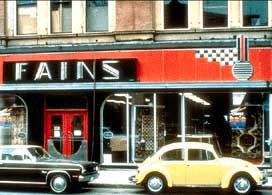
1930s Moderne storefront that has gained significance over time. |
The
storefront is usually the most prominent feature of a historic commercial
building, playing a crucial role in a store's advertising and merchandising
strategy. Although a storefront normally does not extend beyond the first story, the rest of the building is often related to it visually through a unity of form and detail. Planning should always consider the entire building; window patterns on the upper floors, cornice elements, and other decorative features should be carefully retained, in addition to the storefront itself.
The
earliest extant storefronts in the U.S., dating from the late 18th
and early 19th centuries, had bay or oriel windows and provided
limited display space. The 19th century witnessed the progressive
enlargement of display windows as plate glass became available in
increasingly larger units. The use of cast iron columns and lintels
at ground floor level permitted structural members to be reduced
in size. Recessed entrances provided shelter for sidewalk patrons
and further enlarged display areas. In the 1920s and 1930s, aluminum,
colored structural glass, stainless steel, glass block, neon, and
other new materials were introduced to create Art Deco storefronts.
|
|
Storefronts
|
....Identify,
retain, and preserve
|
 |
|
recommended.....
|

|
| |
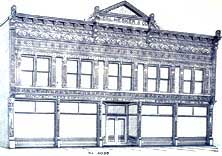
Turn-of-the-century catalog design showing typical storefront components. |
Identifying,
retaining, and preserving storefronts--and their functional and
decorative features--that are important in defining the overall
historic character of the building such as display windows, signs,
doors, transoms, kick plates, corner posts, and entablatures. The
removal of inappropriate, non-historic cladding, false mansard roofs,
and other later alterations can help reveal the historic character
of a storefront.
|
|
not
recommended.....
|

|
| |
Removing
or radically changing storefronts--and their features--which are
important in defining the overall historic character of the building
so that, as a result, the character is diminished.
Changing
the storefront so that it appears residential rather than commercial
in character.
Removing
historic material from the storefront to create a recessed arcade.
Introducing
coach lanterns, mansard designs, wood shakes, nonoperable shutters,
and small-paned windows if they cannot be documented historically.
Changing
the location of a storefront's main entrance.
|
|
Storefronts
|
....Protect
and Maintain
|
 |
|
recommended.....
|

|
| |
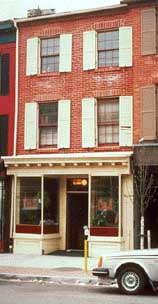
Distinctive 19th century brick and wood storefront in good repair. |
Protecting
and maintaining masonry, wood, and architectural metals which comprise
storefronts through appropriate treatments such as cleaning, rust
removal, limited paint removal, and reapplication of protective
coating systems.
Protecting
storefronts against arson and vandalism before work begins by boarding
up windows and installing alarm systems that are keyed into local
protection agencies.
Evaluating
the overall condition of storefront materials to determine whether
more than protection and maintenance are required, that is, if repairs
to features will be necessary.
|
|
not
recommended.....
|

|
| |
Failing
to provide adequate protection of materials on a cyclical basis
so that deterioration of storefront features results.
Permitting
entry into the building through unsecured or broken windows and
doors so that interior features and finishes are damaged through
exposure to weather or through vandalism.
Stripping
storefront of historic material such as wood, cast iron, terra cotta,
carrara glass, and brick.
Failing
to undertake adequate measures to assure the preservation of the
historic storefront.
|
|
Storefronts
|
....Repair
|
 |
|
recommended.....
|

|
| |
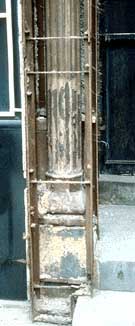
Cast iron column revealed during removal of non-significant storefront. |
Repairing
storefronts by reinforcing the historic materials.
Repairs will
also generally include the limited replacement in kind--or with
compatible substitute materials--of those extensively deteriorated
or missing parts of storefronts where there are surviving prototypes
such as transoms, kick plates pilasters, or signs.
|
|
not
recommended.....
|

|
| |
Replacing
an entire storefront when repair or materials and limited replacement
of its parts are appropriate.
Using
substitute material for the replacement parts that does not convey
the same visual appearance as the surviving parts of the storefront
or that is physically or chemically incompatible.
|
|
Storefronts
|
....Replace
|
 |
|
recommended.....
|

|
| |
Replacing
in kind an entire storefront that is too deteriorated to repair--if
the overall form and detailing are still evident--using the physical
evidence as a model. If using the same material is not technically
or economically feasible, then compatible substitute materials may
be considered.
|
|
not
recommended.....
|

|
| |
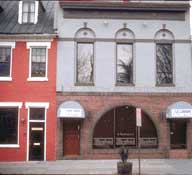
Incompatible replacement storefront and inappropriate window alteration. |
Removing
a storefront that is unrepairable and not replacing it; or replacing
it with a new storefront that does not convey the same visual appearance.
|
| |
Design
for Missing Historic Features
The
following work is highlighted to indicate that it represents the
particularly complex technical or design aspects of rehabilitation
projects and should only be considered after the preservation concerns
listed above have been addressed.
|
|
recommended.....
|

|
| |
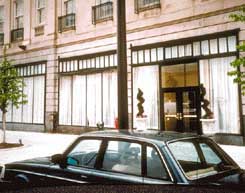 Compatible, contemporary storefront design replaced a later, non-significant storefront. Compatible, contemporary storefront design replaced a later, non-significant storefront. |
Designing
and constructing a new storefront when the historic storefront is
completely missing. It may be an accurate restoration using historical,
pictorial, and physical documentation; or be a new design that is
compatible with the size, scale, material, and color of the historic
building.
|
|
not
recommended.....
|

|
| |
Creating
a false historical appearance because the replaced storefront is
based on insufficient historical, pictorial, and physical documentation.
Introducing
a new design that is incompatible in size, scale, material, and
color.
Using
inappropriately scaled signs and logos or other types of signs that
obscure, damage, or destroy remaining character-defining features
of the historic building.
|
|

